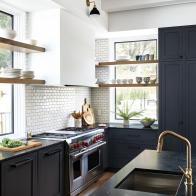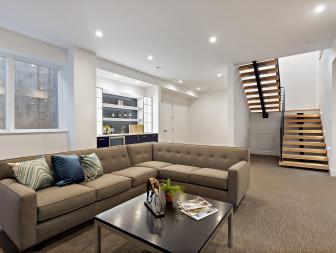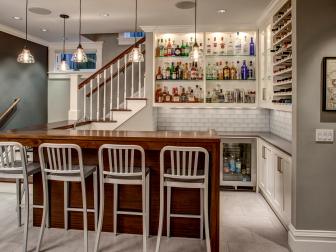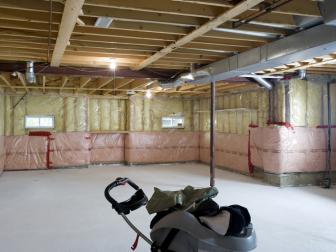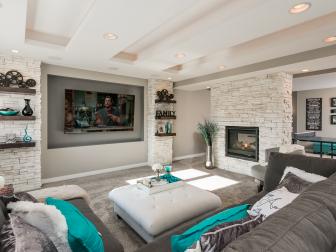How Much Value Does a Finished Basement Add?
A finished basement is a home improvement project you get to enjoy twice: for the added living space, and again at resale when you're paid back for much of the project.

Finishing the basement has become a popular home remodel in recent years, and no wonder: It’s usually the least expensive way to add square footage and is usually easier than packing up and moving to a bigger house. A basement conversion is also customizable to each household, providing an extra bedroom or a home office, a family area or a sanctuary away from one another. The question many homeowners ask is whether a basement remodel is worth the cost.
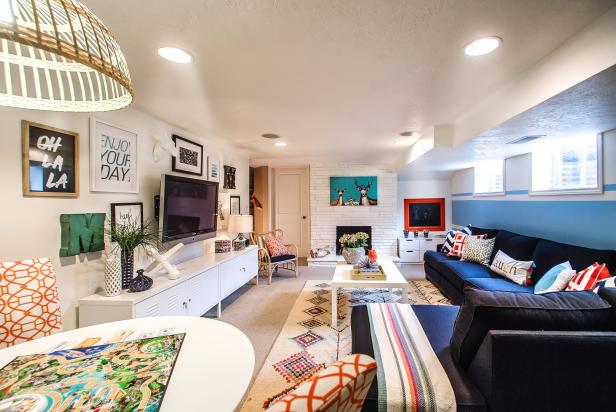
Boise Home Photography
An abundance of color, texture and pattern gives positive energy to this basement playroom. For homeowners ready for more living space, finishing the basement is an attractive alternative to the expense of an addition.
The answer is yes, according to the results of a study conducted by the National Association of Realtors (NAR) and the National Association of the Remodeling Industry (NARI). The 2022 Remodeling Impact Report includes basement conversion to a living area as a top-four interior remodel in terms of return on investment (ROI), with an estimated 86% of the project cost recovered when it’s time to sell. Finishing the basement outperformed seven other projects, including ever-popular kitchen and bathroom renovations. The job was exceeded in value only by hardwood floor refinishing, new wood flooring installation and insulation upgrades — all far less-expensive projects.
Variables Impacting Remodeling Cost
The theoretical basement project in the NAR/NARI study was specific: It involved remodeling half of an unfinished basement into a 15' x 25' TV and playroom with finished walls and ceiling, a carpeted floor, new electric-baseboard heat and new recessed lighting. The job included the installation of two above-grade windows and a door to the unfinished area where the existing laundry area and furnace were located. Survey responses from NARI member contractors estimated the cost at $57,500.
In the real world, differences in basement condition and type of construction, regional pricing variances and the scope of design and finish possibilities mean that the cost of a basement conversion will vary from household to household, running anywhere from $10,000 to more than $100,000. Let’s look at a few major contributors to the price of the job.
Basement Condition
The NAR/NARI basement had no hidden issues. But in the real world, there are a multitude of problems a homeowner can face in an unfinished basement. Mold, humidity, odors, foundation cracks and shifting are common, with moisture frequently the underlying cause. If you don't fix these issues first, laying lovely finishing work atop them is a recipe for an expensive disaster. Cheap and easy fixes include regular gutter maintenance and improving ventilation to stop moisture damage, but some basements require expensive solutions like foundation repairs. Our basement waterproofing guide covers common moisture issues, DIY remedies and when to consult a professional.
Cost: Fixes run the gamut from $100 for minor gutter work to $15,000 for an exterior drain installation.

Werner Straube Photo
Local building codes will dictate many components of the design of a finished basement, including ceiling height, egress and stairs.
Code Compliance
There are strict building codes that apply to a finished basement. The regulatory environment is pretty specific to locale, but these are a couple of pricier requirements one can expect:
- Egress: The International Residential Code (IRC) says that every finished basement requires at least one access opening — a door or window — that can serve as an exit for you and an entrance for first responders during an emergency. Size and location matter and, in some cases, you could require more than one. Cost: Home project online pricing tool HomeAdvisor estimates egress window installation between $2,572 and $5,448, and a basement walkout door between $2,500 and $10,000.
- Stairs: The NAR/NARI basement conversion utilized the existing home stairway, but stairs in some unfinished basements may not be within the code for a finished space. Upgrading the stairs to code can include modifying the rise and run, widening or changing steps to a solid-riser construction and adding handrails or a landing. Cost: Creating new basement stairs costs somewhere between $920 and $2,880 on average.
Room Choice and Amenities
It likely goes without saying that what you want to do with your basement matters quite a bit in terms of cost, with some uses inherently pricier than others. For example, creating a one-bedroom apartment means the baked-in expense of a closet, more than one egress (sometimes), a bathroom, a kitchen and maybe a laundry area. These inclusions add up, making an apartment one of the most expensive basement builds, starting at $63,000 but usually costing a lot more.
The least expensive uses of the space are those that don’t require new utility lines and lack separate rooms, which spares the cost of additional framing, drywall and doors. An office, a gym, a studio or an open-concept family room home (like the NAR/NARI basement conversion) are all inexpensive spaces, relatively speaking.
Popular conveniences that will add to the price tag include a bathroom (averaging $15,000) and a wet bar ($500 to $22,500) or kitchenette (averaging $45,600).
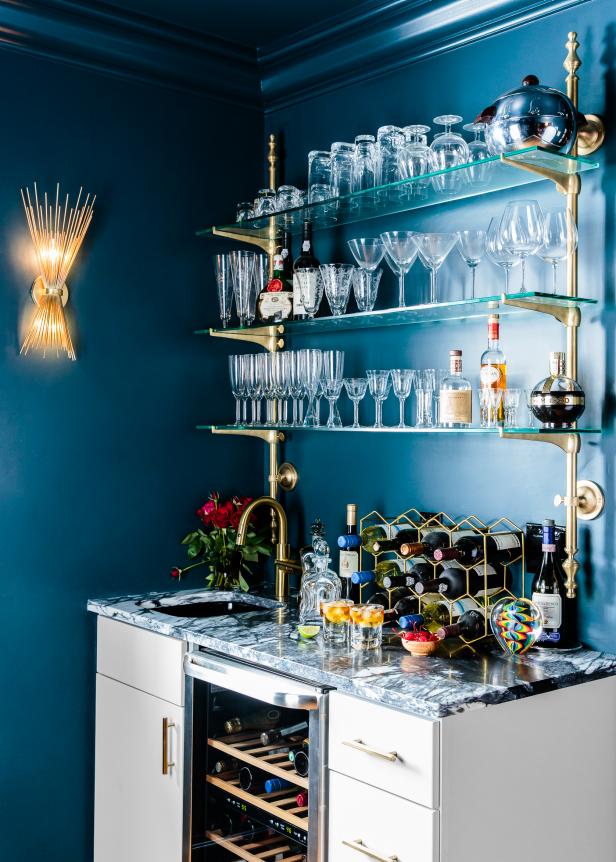
Sean Litchfield
Adding plumbing to a basement can add expense to your project but it may be worth it for the convenience it provides. That said, you might consider if a full kitchenette is needed downstairs. This wet bar with a sink and fridge adds functionality, without sacrificing style or space and could come in at half the price of a kitchenette.
Materials and Design Professionals
According to the NAR/NARI report’s methodology, its basement project used no top-of-the-line materials, but yours can. As you’d expect, using high-end materials and luxury finishes will add to the expense, as will enlisting more talent. A designer or architect arrives with a four-figure invoice, maybe more.
Regional Variations
Where you live in the country matters for your project. Labor and material costs, professional fees, permitting and inspections contribute to these regional differences. HomeAdvisor data indicates that you could expect to pay nearly twice as much for a basement conversion in a New York brownstone than you would for the same project in Denver.
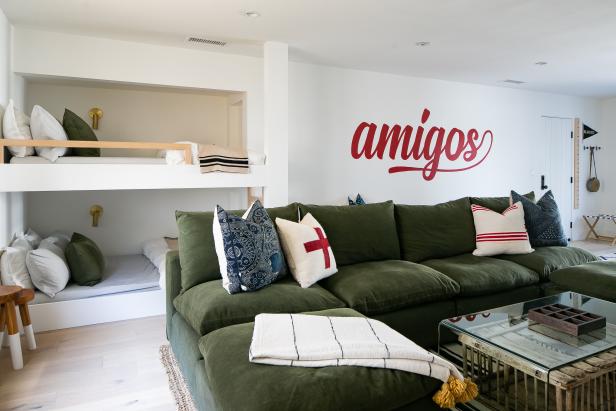
Ryan Garvin
If a home sale is on the horizon, consider finishing the basement into a room with wide appeal. This open-concept family room incorporates bunks into the wall for lounging or overnight guests. Most home buyers could make use of the space.
Variables Impacting ROI
On the other side of the basement-finishing calculation is the value of the changes you made when you sell your home. If you plan to list it in the near future and want to hedge your bets, you’d be wise to consider broader buyer preferences. For example, you can expect one’s room choice — and whether its usefulness is appreciated by future buyers — to make a big impact on value. Sure, some potential buyers will undoubtedly appreciate the minigolf course you’ve created, but all can likely make use of the TV room. In the NAR/NARI report, it was estimated that 86% of the price tag ($49,250 of $57,500) for the family room would be recovered at the time of sale.
Some market influences on buyer preferences are impossible to predict: COVID-19, for example. In the NAR/NARI study, 17% of the surveyed Realtors reported increased demand for basement remodels during the pandemic. With many families experiencing new work-from-home or learn-from-home needs, that figure is unsurprising. Roughly three-quarters of the NAR/NARI study’s homeowners who remodeled their basements said they would have done so, pandemic or no pandemic, which means a quarter of respondents remodeled because of it.
Just as where you live matters for cost, it matters for value, too. For a midrange, basement remodel that included a bathroom and wet bar, the Cost vs. Value Report from Remodeling magazine for 2017 — the most recent year to include basement finishing — estimated a return of 70% nationally but showed wide regional variation. The Pacific region enjoyed a return of 86.4% while in New England it was only 52.8%.
Although the 2022 NAR/NARI report didn’t break down the data geographically, Jessica Lautz, vice president of demographics and behavioral insights at the National Association of Realtors, says that even regional data won’t tell you much. “Every local market will be different,” Lautz explains, adding that every buyer will value the spaces and remodels within the home differently. So, at the end of the day, your basement remodel’s value comes down to the preferences of the individual making an offer on your home.
Alternatives for Increased Living Space
Lautz says that over the last two years many homeowners faced a similar quandary: stay and remodel or move for more space. “Owners looked at their home as a way to add a home office (or two), a gym, a meditation retreat or even a children’s play area,” she says. And the basement isn’t the only option to reclaim living space within the home. In fact, in some areas of the country, basements aren’t common at all, she explains, whereas the attic or the area over the garage are the portions of the home that see conversions. Basement conversation had a lower price tag than attic conversion, and a higher value upon sale, according to the NAR/NARI report. But in both cases, Lautz says, homeowners had a greater desire to stay in their homes after completing the project and cited functionality and livability as important results.
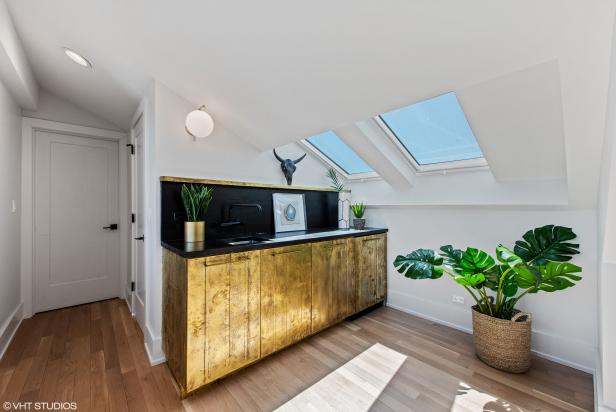
@properties, a member of Luxury Portfolio International
Alternatives to renovating the basement include converting the attic or adding onto the home. This swanky attic enjoys tons of light from a pair of skylights, an elegant gold-tone wet bar and access to a rooftop patio.
Finished Basement vs. Unfinished Basement?
Hardwood floor refinishing, the top interior project in the NAR/NARI report, enjoys a low cost and an estimated return of 147%, making it a project worth doing, period. In fact, nearly a quarter of realtors said they would tell clients to refinish the floors before selling. Basement conversion — with a five-figure project cost in most cases and 86% payback — isn’t there. Additionally, only 5% of Realtors surveyed would tell clients to convert the basement before selling. When asked if there is a type or location of home for which it is advisable, Lautz points out that resale is likely not a top motivator for a large-scale project that could face delays in completion. She says, “When thinking about remodeling a space, an owner should always think if they will find joy in the completed result.”
To that point, the NAR/NARI study asked homeowners how happy they were after completion of their recent projects, and basement conversion received a joy score of 9.7 out of 10, with the vast majority of people reporting a greater desire to be home. Then, Lautz has some general advice for homeowners who do have a sale on the horizon. “For any remodel, ensure the potential buyer knows the year the remodel was done and any special and luxury finishes that they may enjoy,” she says. “This can maximize [the number of] buyers who are attracted to the home.”




